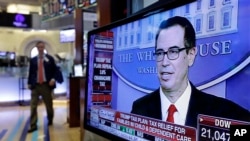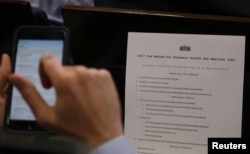President Donald Trump's plan to slash business and household taxes could shift the U.S. economy into higher gear, but it may have one effect the White House would not welcome — interest rates ratcheted higher than expected by a wary central bank.
The Trump administration says hundreds of billions of dollars fed into the economy via deep cuts in business taxes and more generous exemptions for individuals will unleash a wave of investment and make the U.S. economy more competitive than ever.
But the plan, if approved in the form Trump officials outlined on Wednesday, could add inflationary fuel to an economy already running near full capacity, a risk Federal Reserve officials have been warning about since Trump got elected.
Confronted with the prospect of massive cuts that would slash the corporate tax rate to 15 percent from 35 percent and overhaul the personal tax code, Fed officials will need to start debating if they can maintain a measured pace of rate hikes or they might need to move faster, say analysts and economists who follow the U.S. central bank.
Fed’s inflation goal is 2 percent
The Fed aims to hold inflation at around 2 percent, and is close to that threshold, with its target short term rate expected to rise two more times, to about 1.5 percentage points, by the end of the year.
Trump has said he hopes low rates will continue, a potential source of friction with the Fed if officials do decide they need to move faster because of his policies.
An estimated up to $700 billion a year in tax cuts could threaten to derail such a scenario, especially if not all of that money finds its way into productive investments, or drives price and wage hikes.
“The premise is that all the tax savings get plowed into high-return investments to generate growth. But if they don't and they just get churned around into M&A and other financial engineering things, it's even worse because you're raising risks elsewhere in the economy,” said Mark Mazur, former U.S. treasury assistant secretary for tax policy during the Obama administration, now head of the Urban-Brookings Tax Policy Center in Washington.
Uncertainty as to whether and in what shape the plan will get implemented adds to other challenges the Fed faces in trying to chart its course over the next several months.
Looming threats
The threat of a government shutdown and renewed debate over the federal debt ceiling late this summer or early in the fall will test both the new administration and the Fed's ability to set its policy course. Republican and Democratic lawmakers need to pass a series of bills to keep the government running, but are sparring over issues such as whether to fund a border wall with Mexico.
Government closures, forced budget cuts, and a tense 2013 debt ceiling debate have thrown the Fed off course before, dragging down economic growth and idling hundreds of thousands of workers.
Taken together, the coming discussions will be critical for the Fed and for world markets looking for proof Trump can oversee a functioning government, said David Stockton, a former Fed research director now with the Peterson Institute of International Economics.
“If you have a shutdown followed by a serious flirtation with default ... some of the optimism built into household and business confidence could deflate and deflate pretty quickly,” Stockton said. “If all of a sudden it begins to look like even with one party in control nothing seems to be happening, it could be a shock.”
For the Fed, those would be self-inflicted wounds in an otherwise calm economic environment. From healthy corporate profits to strong consumer confidence and geopolitical developments like the recent French election results, events have been breaking in favor of steady U.S. growth and job gains — and a gradual pace of Fed rate increases.
Policymakers are hesitant
Policymakers currently foresee two more rate increases this year, a view investors largely accept in how they have priced different securities.
So far, policymakers have been hesitant to mold their thinking too much around speculation about what Trump might do because details have been scant and Congress' reaction uncertain.
With the scope of the tax plan now revealed and fiscal deadlines on the horizon, that is now likely to change — for better or worse.
Though the Republicans now control both the White House and the Congress, there is no guarantee they will easily reach agreement on either spending or tax plans, or on the debt ceiling. Divisions in the GOP doomed Trump's first stab at healthcare overhaul, and some Republican lawmakers are likely to oppose either raising the debt limit or cutting taxes too much because of the larger deficits that would produce.
“The next few months are going to be make or break. They are going to have to show they are going to get something done,” said IHS Markit economist Chris Christopher.









